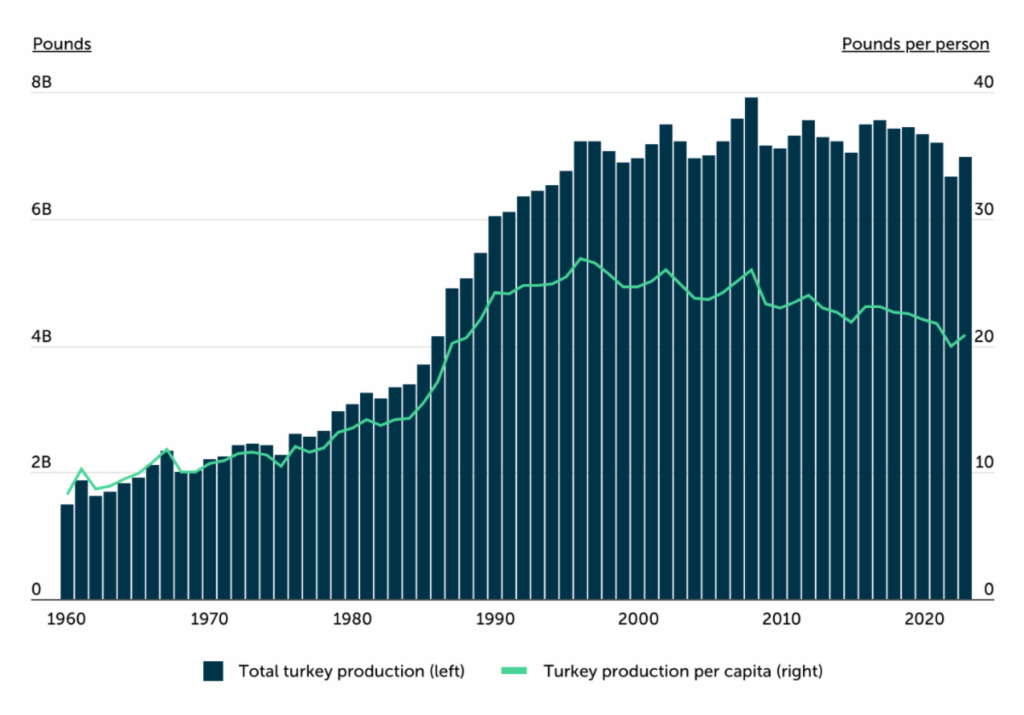*A new study on behalf of Trace One has identified the top U.S. states for turkey production.
Thanksgiving remains one of the most widely celebrated holidays in the United States, with over 90% of Americans observing the tradition each year. For many, it ranks as a favorite holiday, bringing together family and friends around a meal that often centers on one iconic dish: roast turkey.
Yet, few people consider the agricultural effort behind this holiday staple. Each year, an estimated 46 million turkeys are consumed on Thanksgiving alone, with production largely concentrated in a handful of states. As the holiday nears, these leading turkey-producing states work hard to support millions of Thanksgiving tables nationwide. Here, we take a closer look at the regions making this tradition possible.
Trends in U.S. Turkey Production & Consumer Demand
Americans are eating less turkey than in years past

Over the decades, U.S. turkey production has seen significant growth followed by a more recent decline. Between 1960 and the mid-1990s, per capita turkey production rose sharply, peaking in 1996 at 26.8 pounds per person. However, between the mid-1990s and present, per capita turkey production experienced a fairly steep decline. In 2022, annual production had dropped to just 20 pounds per person—a decline of approximately 25%. On an absolute basis, total turkey production peaked in 2008 at 7.9 billion pounds before dropping to an average of around 7 billion annually in recent years.
Several factors can explain this shift in consumer demand. Health concerns and changing dietary preferences play a significant role, with more Americans choosing plant-based diets and reducing overall meat consumption, including turkey. Additionally, rising turkey prices, which increased from $0.80 per pound in 2018 to $1.40 per pound in 2023, have also impacted consumption.
Average Turkey Weight
The average turkey size in the U.S. has nearly doubled since the 1960s

Interestingly, the average size of turkeys raised in the U.S. has nearly doubled since the 1960s, a trend that has helped maintain relatively high production levels even as the total number of turkeys raised has declined.
The number of turkeys raised peaked in 1996 at approximately 303 million birds annually but has since dropped by about 30% to an estimated 218 million birds in 2023. However, the larger size of today’s turkeys—averaging 32 pounds per bird compared to around 18 pounds in the 1960s—has offset the decline in numbers, resulting in a relatively less pronounced decrease in overall production weight.
The increase in average turkey size is primarily due to selective breeding focused on larger, faster-growing birds. Advances in nutrition, health, and farming practices have also contributed, allowing turkeys to reach target weights more efficiently. While larger turkeys are generally more economical on a per-pound basis, experts point out that smaller birds offer certain advantages: they tend to be more tender, cook more evenly, and require significantly less time for thawing and cooking. For larger gatherings, preparing two smaller birds instead of a single large one has the added benefit of increasing the quantity of popular cuts, such as wings, drumsticks, and thighs.
Turkey Production by State
North Carolina & Minnesota are the top turkey producers in the nation

More than 85% of U.S. turkey production takes place in just 13 states, with North Carolina and Minnesota leading as the top producers. Together, these two states contribute more than 30% of the nation’s total turkey output. North Carolina ranks first, accounting for 15.3% of turkeys by weight, driven in part by a larger average bird size of 36.9 pounds. Minnesota, where turkeys tend to be smaller, ranks second in production weight at 15.1% but raises the largest number of turkeys overall, accounting for 17.7% of the nation’s total birds.
Outside of North Carolina and Minnesota, Indiana is a major producer, contributing 11.9% of U.S. turkey production by weight, followed by Arkansas at 7.8% and Iowa at 7.3%. In general, turkey production is largely concentrated along or east of the Mississippi River, although California stands out as a notable exception.
This analysis was conducted by Trace One—a company specializing in regulatory compliance for the food and beverage industry—using data from the U.S. Department of Agriculture (USDA). For complete results, refer to the original post: The States You Can Thank for Your Turkey Dinner.
Here is a summary of the data for California:
- Turkey production (pounds): 197,780,000
- Turkey production value (dollars): $185,913,000
- Turkeys raised: 6,200,000
- Average turkey size (pounds): 31.9
- Share of U.S. turkey production: 2.8%
- Share of U.S. turkeys raised: 2.8%
For reference, here is the data for the United States:
- Turkey production (pounds): 6,985,916,000
- Turkey production value (dollars): $6,566,760,000
- Turkeys raised: 218,000,000
- Average turkey size (pounds): 32.0



